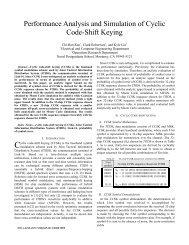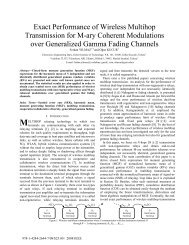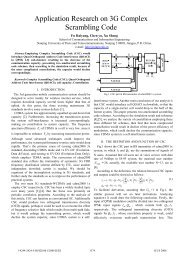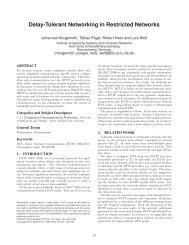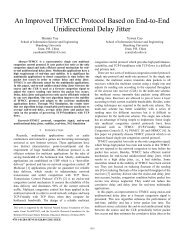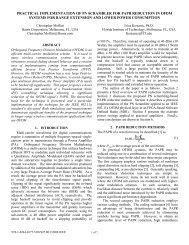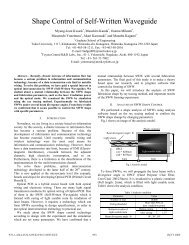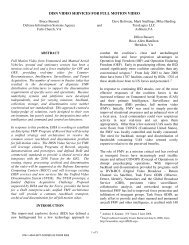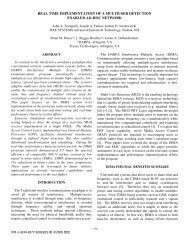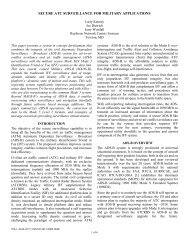2. Research On Streaming Media Online Charging System
2. Research On Streaming Media Online Charging System
2. Research On Streaming Media Online Charging System
Create successful ePaper yourself
Turn your PDF publications into a flip-book with our unique Google optimized e-Paper software.
A. A brief introduction to streaming media<br />
<strong>Streaming</strong> media refers to the continuous audio/video<br />
stream being transmitted and broadcasted on data network<br />
according to time sequence. With the progress of 3G networks<br />
and the improvement of network condition, the streaming<br />
media services develop rapidly and attract more and more<br />
attention. There has been a streaming media subject- "highperformance<br />
information broadband network 3TNet" subject<br />
that belongs to China’s "863 project". Beginning with typical<br />
broadband streaming media services such as Internet TV, VoD,<br />
High Definition TV, Time-Shifted TV and so on, the subject<br />
established a high-performance, WAN (MAN) broadband<br />
demonstration network 3TNet which is applicable to real-time<br />
transmission of Internet TV and other media streams, and it<br />
was deployed in the Yangtze-River-Delta region. It is so far the<br />
largest integrated application platform for IPv6 interactive<br />
multimedia broadband network.<br />
B. Architecture of <strong>Streaming</strong> <strong>Media</strong> <strong>On</strong>line <strong>Charging</strong> <strong>System</strong><br />
The function of <strong>On</strong>line <strong>Charging</strong> <strong>System</strong> (OCS) is to<br />
response to charging requests in real time, finish rating<br />
according to billing policies, give feedbacks after deducting<br />
corresponding service fees and generate billing details.<br />
Furthermore, OCS ought to monitor customers’ account<br />
balance and control service consumption in real time. In the<br />
specification of R5 & R6, 3GPP proposed OCS and defined the<br />
reference framework of OCS for IMS network [6]. The OCS<br />
proposed by 3GPP is aimed at charging requirements of<br />
telecom services and it is complex to support CAMEL<br />
protocol. However, streaming media services have their own<br />
features as multimedia, personalized interaction,<br />
humanization, and their supporting networks are almost IPbased<br />
broadband networks. In order to make the SMOCS<br />
support streaming media services more effective and the<br />
system be more scalable and more compatible, we design a<br />
Common Interface Function (CIF) module to unify the<br />
interaction with external devices, add the Session Management<br />
module to monitor charging request session information and<br />
adopt DiameterCC protocol to interact with streaming media<br />
service control servers. <strong>On</strong> the principle of the separation<br />
between billing control and billing applications, according to<br />
function requirements of OCS in streaming media applications,<br />
taking advantage of 3GPP’s related research achievements<br />
[14], we designed architecture of <strong>Streaming</strong> <strong>Media</strong> <strong>On</strong>line<br />
<strong>Charging</strong> <strong>System</strong> and it consists of Common Interface module,<br />
<strong>Charging</strong> module, Account Balance Management module,<br />
<strong>Charging</strong> gateway module, Rating module and Session<br />
Management module. The detailed architecture of SMOCS is<br />
shown in Figure 1.<br />
310<br />
Figure 1. Framework of the <strong>Streaming</strong> <strong>Media</strong> <strong>On</strong>line <strong>Charging</strong> <strong>System</strong><br />
Access Convergence Router (ACR) and <strong>Media</strong> Server (MS)<br />
are service control network elements in streaming media<br />
application systems. They interact with SMOCS by<br />
DiameterCC Protocol and realize the online charging function<br />
in coordination. ACR in the backbone of network controls the<br />
multicast of Internet TV, High Definition TV, Broadband<br />
access, etc. MS around the edge of Metropolitan Area Network<br />
(MAN) provides streaming service of VoD, Time-Shifted TV,<br />
Time-shift VoD and other stream services for terminals.<br />
SMOCS specifies a CIF module to unify the interaction with<br />
external network devices and enhance the system’s<br />
compatibility. CIF module interacts with external network<br />
devices through DiameterCC Protocol and IPDR [10] file for<br />
real-time billing information and billing details respectively;<br />
<strong>Charging</strong> function module is one of control modules and it<br />
supports charging function based on session, beater and events;<br />
Rating function module is the charge calculation module and it<br />
supports charging calculation for a variety of services through<br />
configuration of billing rules; Main function of Account<br />
Balance Management Function (ABMF) is monitoring<br />
customers’ account balance, including reserving/releasing<br />
account balance, deducting service fees, inquiring real-time<br />
balance, etc. When a customer’ balance is below a dynamically<br />
calculated threshold based on the customer’s level and history<br />
bill records, the module reminds the customer to recharge<br />
through short messages or E-mails; Main function of Session<br />
Management Function (SMF) is to establish/close sessions,<br />
monitor status of sessions and maintain session information;<br />
According to pre-determined strategy in SMOCS, charging<br />
Gateway produces IPDR files for further dealings in<br />
accounting system [8].<br />
C. <strong>Research</strong> on the AAA protocol<br />
The Remote Authentication Dial In User Service<br />
(RADIUS) protocol is one of the most popular AAA protocols<br />
and it is widely used for its simpleness, easy management and<br />
nice expansibility. However, RADIUS protocol can’t be<br />
adapted to current networks for its own defects, such as<br />
transmission by the unreliable UDP protocol, simple package<br />
drop mechanism, without rules about retransmission and the<br />
concentrated billing service mechanism. So the Diameter<br />
protocol [10] is proposed. The Diameter protocol provides a<br />
safe, reliable and scalable framework for various authentication<br />
authorization and accounting services, and it can be applied to<br />
practical applications conveniently. Compared to RADIUS<br />
protocol, Diameter protocol has a nice mechanism to handle<br />
transmission failure, the ability to rapidly detect the receiving<br />
peer, and a better package drop mechanism. In addition, it<br />
supports end-to-end security and makes authenticates and<br />
authorizes for each session to ensure security. Based on<br />
Diameter, DiameterCC protocol defines a billing mechanism<br />
for prepaid services, adopts credit control mechanism to realize<br />
session based charging, bearer based charging and event based<br />
charging. And it satisfies billing requirements for prepaid<br />
services. Therefore, SMOCS designed in this paper interacts<br />
with external network devices by this protocol to realize online<br />
charging function.



